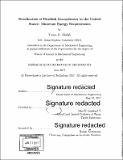Desalination of brackish groundwater in the United States : minimum energy requirements
Author(s)
Ahdab, Yvana D. (Yvana Daniella)
DownloadFull printable version (15.09Mb)
Other Contributors
Massachusetts Institute of Technology. Department of Mechanical Engineering.
Advisor
John H. Lienhard, V.
Terms of use
Metadata
Show full item recordAbstract
Water scarcity around the globe has motivated rising interest in desalinating brackish groundwater to meet fresh water demand. Various organizations in the United States have collected more hydrological and chemical data from the growing number of wells. Yet, only one national assessment of groundwater resource distribution and availability has been conducted in the United States since the 1960s, and no national assessment has been conducted on the energy costs required to make brackish groundwater potable. Because the ionic composition of groundwater varies significantly from location to location, unlike seawater, conducting site-specific analyses of the resource across the U.S. is necessary. This thesis uses chemical and physical data from a U.S. Geological Survey dataset compiled in 2017, including samples from over 100,000 groundwater wells across the United States, to carry out a nationwide investigation of brackish groundwater composition and minimum desalination energy costs. Beginning with a full Pitzer-Kim mixed electrolyte model, we develop a thermodynamic analysis of the least work of separation in order to compute the site-specific least work of separation required for groundwater desalination. Least work of separation represents a baseline for specific energy consumption of real-world desalination systems. Then, we study the geographic distribution of least work of separation to determine areas with both low least work of separation and high water stress. These regions hold potential for desalination to decrease the disparity between high water demand and low water supply. We develop simplified equations for least work as a function of recovery ratio and the following parameters: total dissolved solids, specific conductance, ionic strength, and molality. Lastly, we examine the effects of groundwater composition on minimum energy costs, and the geographic distribution of total dissolved solids, well depth and major ions.
Description
Thesis: S.M., Massachusetts Institute of Technology, Department of Mechanical Engineering, 2017. Cataloged from PDF version of thesis. Includes bibliographical references (pages 119-122).
Date issued
2017Department
Massachusetts Institute of Technology. Department of Mechanical EngineeringPublisher
Massachusetts Institute of Technology
Keywords
Mechanical Engineering.